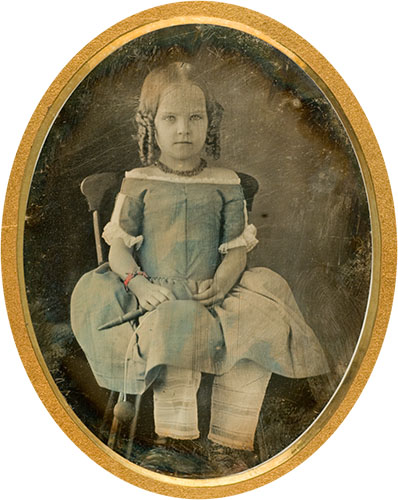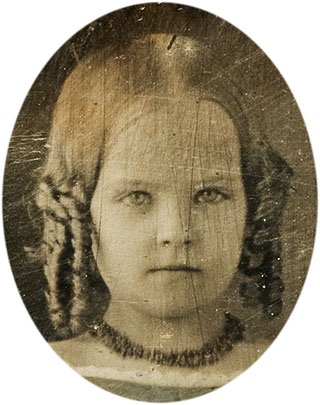This is a unique size and presentation. The full case is 6th plate in size, however the image is approximately a 9th plate. It actually is cut as an oval and taped to the back of the mat. This is not just a one-off example, as the mat is sized for it and appears to be a production quality mat. This is kind of a clever marketing ploy, as the picture is smaller and cheaper to make, yet it is put in a larger case to appear more substanial. |
- Mat Style and weight
- Preserver style
- Girl's style
This is a fascinating example of a c. 1850 daguerreotype. While the image has some scratches (it is over 160 years old), the resolution and clarity are a testament to the quality of the daguerreotype process in the hands of an expert.
Case
The case is by the famous case maker William Shew. An advertisement is under the image. The case lid is covered with red silk, which was used in early cases. By the late 1840s, velvet with the a design or the photographers name was embossed on the inside. The silk dates the case to before 1850.
Packaging
The mat style (brass plate with oval cutout) is very heavy with a textured yet smooth finish. This is indicative of the late 1840s to very early 50s. The preserver (brass frame around the mat) did not come into being until about 1847. The first ones were very stiff brass, as is this one. As the 1850s progressed, they became thinner and more flexible.
|
Estimated Date: 1849 +- 2 yr
The heavy nature of the daguerreotype packaging (mat and preserver) place this sample in the late 1840s to the early 1850s. Her clothes and setting reinforce this.
Click here for other daguerreotype images.
Girl's Style
The girl's hair style is typical of the 1850 era. Her sleeves and shoulder treatment are also from around 1850.
In addition to the excellent composition and photography skills present, the dress was tinted a light blue, and a bracelet on her right arm was tinted with red dye. More evidence of a finely produced, and probably expensive daguerreotype. |

The viewable portion of the daguerreotype is only 1.75" wide, yet reveals amazing detail. The toy in her hand wasn't noticed until the image was copied and enlarged. The image below shows the toy, which was a cup attached to short staff, and a ball was attached to the toy via a length of rope or twine. The goal was to swing the ball with an upward motion and catch it in the cup. |

Enlarged even further, you can see the amount of detail the daguerreotype process could capture. This face portion of the actual daguerreotype is less than 1/2 inch wide. At this level of magnification you can see the wipe marks and scratches also, though it is still an amazing example of early photography.
|
|
|
|